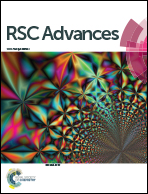Microwave-assisted synthesis of Au/CdS nanorods for a visible-light responsive photocatalyst
Abstract
In this work, cadmium sulfide (CdS) is used as a visible-light responsive photocatalyst with a narrow band gap (2.42 eV). CdS nanorods were synthesized by a facile and rapid microwave-assisted method and Au dots were decorated on the surface by a reduction method. The additions of the Au dots hinder the recombination of electron–hole pairs and enhance the photocatalytic activity under visible light. The photocatalytic activity of the Au/CdS nanorods was evaluated by the photodegradation of methylene blue (MB) under visible light irradiation (455 nm LED lamp). The photocatalytic efficiency of Au/CdS nanorods is compared to conventional TiO2 (P25) and CdS-A prepared by an autoclave method, and an improvement of the Au/CdS system, attributed to the reduced band gap energy (2.31 eV) and enhanced absorption in the range of 400 to 800 nm, was observed. The calculated mineralization ratio of MB by Au/CdS nanorods was higher compared to the data presented in the literature. This facile and efficient synthesis route may promote the utilization of Au/CdS nanorods as visible light photocatalysts.


 Please wait while we load your content...
Please wait while we load your content...